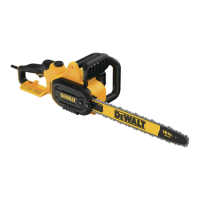ENGLISH
6
IMPORTANT SAFETY INSTRUCTIONS
WARNING: To reduce risk of injury:
• Before any use, be sure everyone using this unit
reads and understands all safety instructions and
other information contained in this manual.
• Save these instructions and reviewfrequently.
WARNING: When using electric gardening appliances,
basic safety precautions should always be followed to
reduce risk of fire, electric shock, and personal injury,
including thefollowing.
1 . Avoid Dangerous Environment – Don’t use appliances
in damp or wetlocations.
2 . Don’t Use InRain.
3 . Keep Children Away – All visitors should be kept at a
distance from workarea.
4 . Dress Properly – Do not wear loose clothing or jewelry.
They can be caught in moving parts. Use of rubber gloves
and substantial footwear is recommended when working
outdoors. Wear protective hair covering to contain
longhair.
5 . Use Safety Glasses – Always use face or dust mask if
operation isdusty.
6 . Use Right Appliance – Do not use appliance for any job
except that for which it isintended.
7 . Ground Fault Circuit Interrupter (GFCI) protection
should be provided on the circuit(s) or outlet(s) to
be used for the gardening appliance. Use a residual
current device with a tripping current of 30mA or less.
Receptacles are available having built‑in GFCI protection
and may be used for this measure of safety.
8 . Warning – To reduce the risk of electric shock, use
only with an extension cord intended for outdoor
use, such as an extension cord of cord type SW‑A,
SOW‑A, STW‑A, STOW‑A, SJW‑A, SJOW‑A, SJTW‑A. or
SJTOW‑A.
9 . Extension Cord – Make sure your extension cord is in
good condition. When using an extension cord, be
sure to use one heavy enough to carry the current
• Replacement Saw Chain ‑ A chain that complies with
kickback performance requirements of ANSI B175.1–2012
when tested with specific chain saws. It may not meet
the ANSI performance requirements when used with
othersaws.
• Saw Chain ‑ A loop of chain having cutting teeth, that cut
the wood,and that is driven by the motor and is supported
by the guidebar.
• Ribbed Bumper ‑ The ribs used when felling or bucking to
pivot the saw and maintain position whilesawing.
• Switch ‑ A device that when operated will complete or
interrupt an electrical power circuit to the motor of the
chainsaw.
• Switch Linkage ‑ The mechanism that transmits motion
from a trigger to theswitch.
• Switch Lockout ‑ A movable stop that prevents
the unintentional operation of the switch until
manuallyactuated.
Chain Saw Names and Terms
• Bucking ‑ The process of cross cutting a felled tree or log
intolengths.
• Motor Brake (if equipped) ‑ A device used to stop the saw
chain when the trigger isreleased.
• Chain Saw Powerhead ‑ A chain saw without the saw
chain and guidebar.
• Drive Sprocket or Sprocket ‑ The toothed part that drives
the sawchain.
• Felling ‑
The process of cutting down atree.
• Felling Back Cut ‑
The final cut in a tree felling operation
made on the opposite side of the tree from the notchingcut.
• Front Handle ‑ The support handle located at or toward
the front of the chainsaw.
• Front Hand Guard ‑ A structural barrier between the front
handle of a chain saw and the guide bar, typically located
close to the hand position on the fronthandle.
• Guide Bar ‑ A solid railed structure that supports and
guides the sawchain.
• Scabbard/Guide Bar Cover ‑ Enclosure fitted over guide
bar to help prevent tooth contact when saw is not inuse.
• Kickback ‑ The backward or upward motion, or both of the
guide bar occurring when the saw chain near the nose of
the top area of the guide bar contacts any object such as a
log or branch, or when the wood closes in and pinches the
saw chain in thecut.
• Kickback, Pinch ‑
The rapid pushback of the saw which
can occur when the wood closes in and pinches the moving
saw chain in the cut along the top of the guidebar.
• Kickback, Rotational ‑ The rapid upward and backward
motion of the saw which can occur when the moving saw
chain near the upper portion of the tip of the guide bar
contacts an object, such as a log orbranch.
• Limbing ‑ Removing the branches from a fallentree.
• Low‑Kickback Chain ‑ A chain that complies with the
kickback performance requirements of ANSI B175.1–2012
(when tested on a representative sample of chain saws.)
• Normal Cutting Position ‑ Those positions assumed in
performing the bucking and fellingcuts.
• Notching Undercut ‑ A notch cut in a tree that directs the
tree’sfall.
• Rear Handle ‑ The support handle located at or toward
the rear of thesaw.
• Reduced Kickback Guide Bar ‑ A guide bar which has
been demonstrated to reduce kickbacksignificantly.
handed operation. A chain saw is intended for two‑handed
useonly.
• Keep the handles dry, clean, and free of oil orgrease.
• Do not allow dirt, debris, or sawdust to build up on the
motor or outside airvents.
• Stop the chain saw before setting itdown.
• Do not cut vines and/or small underbrush.
• Use extreme caution when cutting small size brush and
saplings because slender material may catch the saw chain
and be whipped toward you or pull you offbalance.

